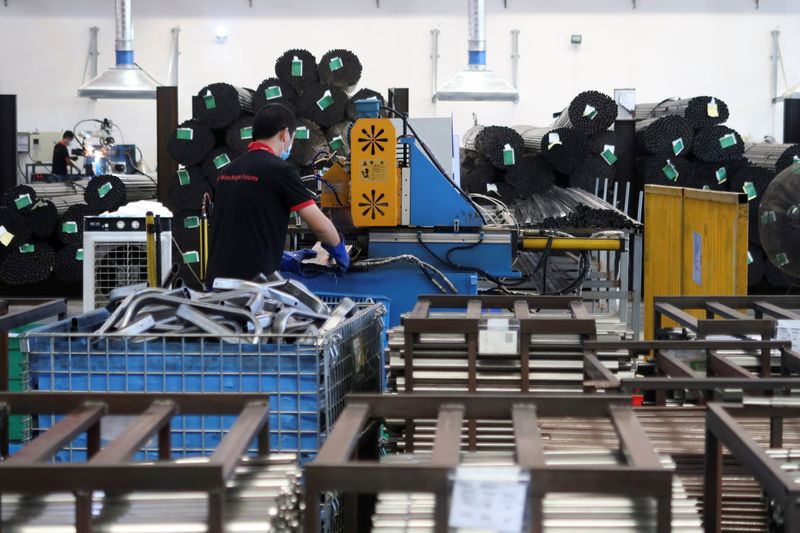BEIJING (Reuters) -China's factory activity unexpectedly shrank in September due to wider curbs on electricity use and elevated input prices, while services returned to expansion as COVID-19 outbreaks receded, offering some relief to the world's second-biggest economy.
The official manufacturing Purchasing Manager's Index (PMI) was at 49.6 in September versus 50.1 in August, data from the National Bureau of Statistics (NBS) showed on Thursday, slipping into contraction for the first time since February 2020.
Analysts in a Reuters poll had expected the index to remain steady at 50.1, unchanged from the previous month. The 50-point mark separates growth from contraction.
China's economy rapidly recovered from a pandemic-induced slump last year, but momentum has weakened in recent months, with its sprawling manufacturing sector hit by rising costs, production bottlenecks and electricity rationing.
Rising COVID-19 cases in tens of cities over the summer also disrupted the manufacturing and the services sectors, though the latter is starting to bounce back as the outbreaks receded.
A sub-index for factory output contracted in September for the first time since February last year, dragged down by a pullback in high-energy consuming industries, such as plants that process metals and oil products. The gauge stood at 49.6 versus 50.1 a month earlier.
"In September, due to factors such as low volumes of business at high energy-consuming industries, the manufacturing PMI fell below the critical point," said Zhao Qinghe, a senior NBS statistician, in an accompanying statement.
"The two indexes of high energy-consuming industries ...are both lower than 45.0, indicating a significant drop in supply and demand."
GROWTH OUTLOOK
The sudden contraction in factory activity will further weigh on an economy already hit by curbs on its property and tech sectors and facing many growth downgrades by private-sector economists.
Other economies in Asia are also grappling with production issues due to supply chain disruptions, with data on Thursday showing Japan's industrial output falling for a second straight month in August.
"(Chinese) economic growth in Q4 will likely slow further without a change of government policies, and the pace of slowdown may pick up," said Zhiwei Zhang, Shenzhen-based chief economist at Pinpoint Asset Management, after the PMI data was released.
"The big question is whether the government's monetary and fiscal policies will become more supportive now or if the government will wait till the year-end to change the policies."
The central bank last eased its requirements on how much cash banks should hold in mid-July, just before a surge in domestic COVID-19 cases.
The People's Bank of China (PBOC) has left its benchmark lending rate for corporate and household loans unchanged for the 17th month in September.
HIGH PRODUCTION COSTS
A shortage of coal, tougher emissions standards and strong demand from manufacturers and industry pushed coal prices to record highs and triggered widespread curbs on electricity usage in at least 20 provinces and regions.
Higher raw material prices, especially of metals and semiconductors, have also pressured profits of manufacturers. Earnings at China's industrial firms in August slowed for the sixth straight month.
A sub-index for raw material costs rose to 63.5 in September from 61.3 a month earlier, while a gauge of new orders came in at 49.3 compared with 49.6 in August, shrinking for the second straight month.
A sub-index for employment remained in contraction, at 47.8 versus 47.0 a month earlier.
A separate private survey also released on Thursday that focuses on small and export-oriented businesses showed that factory activity in September neither expanded nor contracted.
On a more sanguine note, the official non-manufacturing PMI in September was at 53.2, bouncing back from 47.5 in August, data from the NBS showed, as COVID-19 outbreaks receded after rising during the summer months.

Last month, COVID-19-related restrictions drove services sector activity into sharp contraction for the first time since the height of the pandemic last year.
The official September composite PMI, which includes both manufacturing and services activity, stood at 51.7 versus 48.9 in August.